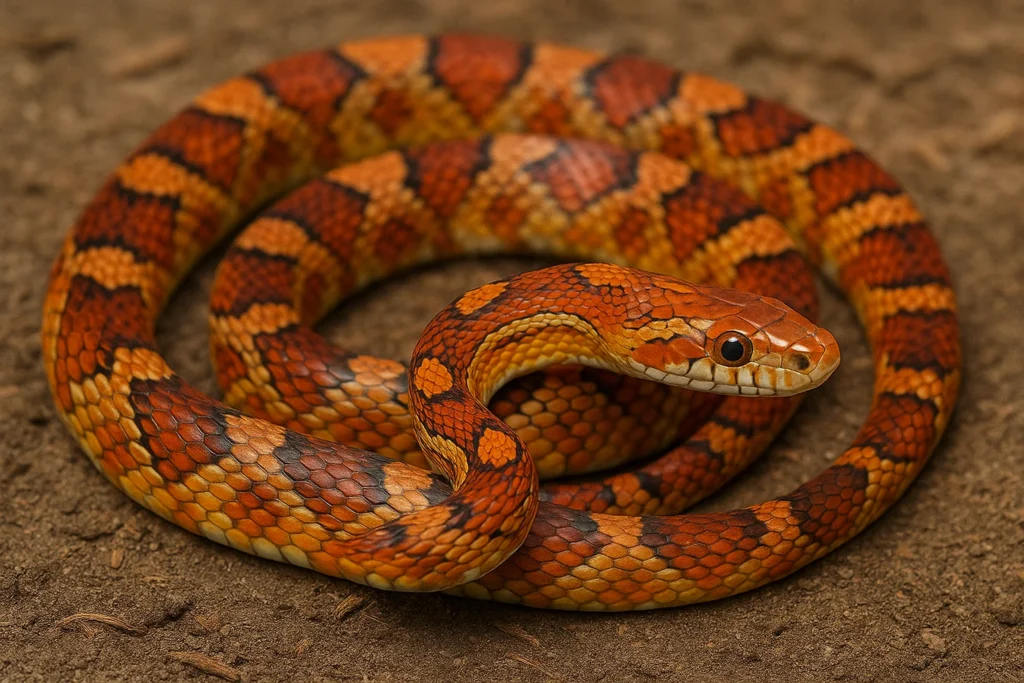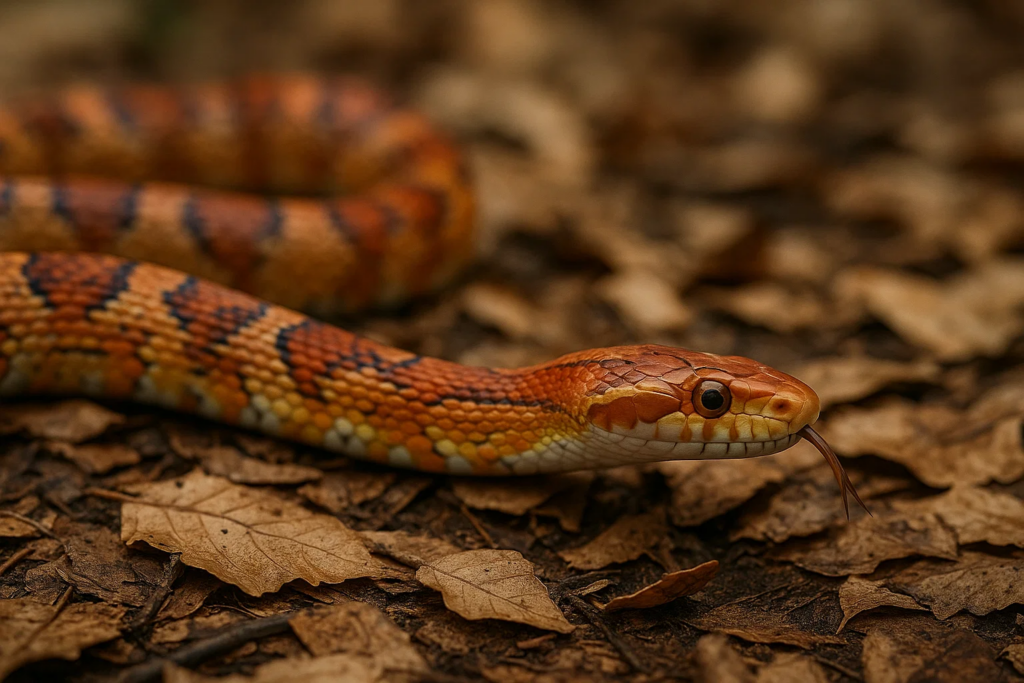
corn snake
introduction to corn snake
When you think of snakes that have successfully slithered their way into human homes and hearts, the corn snake is likely at the top of the list. Known for their docile nature, beautiful color patterns, and relatively easy care requirements, corn snakes (Pantherophis guttatus) are often considered one of the best pet snakes for both beginners and experienced herpetologists alike.
But there’s more to these captivating reptiles than meets the eye. From their natural habitat and biology to their behavior and care in captivity, this comprehensive article explores everything you need to know about corn snakes—and why they just might be the perfect reptilian companion.
What Is a Corn Snake?

Corn snakes are a species of North American rat snake native to the southeastern and central United States. Despite their name, they don’t eat corn, nor are they found in cornfields by preference. The name actually comes from their frequent presence in barns and grain stores, where they prey on rodents attracted to stored corn.
These snakes are non-venomous constrictors, which means they kill their prey by wrapping around it and squeezing until it suffocates. Their diet in the wild primarily consists of small mammals, birds, and sometimes lizards or frogs.
Corn snakes are often mistaken for the venomous copperhead due to their similar coloring, which unfortunately leads to unnecessary killing of these harmless snakes. In reality, they pose no danger to humans and are beneficial in controlling rodent populations.
Taxonomy and Natural History
Scientific name: Pantherophis guttatusFamily: Colubridae
Subfamily: Colubrinae
Lifespan: 15–20 years in captivity (shorter in the wild)
Average size: 3 to 5 feet in length
Corn snakes belong to the Colubridae family, the largest snake family in the world, which includes many non-venomous species. They’re closely related to other rat snakes and kingsnakes, sharing many behaviors and ecological roles.
Their natural range extends from New Jersey down to Florida and as far west as Texas. They prefer habitats like overgrown fields, forest openings, and abandoned buildings—anywhere rodents might be found.
Corn Snakes in the Wild: Ecosystem Role and Predators
In their native environment, corn snakes are important players in the ecosystem. By preying on rodents and other small animals, they help maintain a balanced food chain and reduce potential agricultural damage caused by pests. They’re stealthy hunters that use constriction to subdue their prey and are equipped with excellent climbing ability, allowing them to hunt in trees as well as on the ground.
Natural predators of corn snakes include birds of prey such as hawks and owls, as well as larger snakes and mammals like raccoons and foxes. Camouflage is their main defense mechanism; their distinctive pattern blends well into leaf litter and forest floor environments.
Corn Snake Morphs and Colors
One of the most fascinating aspects of corn snakes, especially for pet owners, is the vast array of color morphs available through selective breeding. Unlike their wild counterparts that sport a reddish-orange body with black-bordered blotches, captive-bred corn snakes come in hundreds of morphs. corn snake
Some popular corn snake morphs include:
Albino (Amelanistic): Lacks black pigment, resulting in vibrant orange, red, and white tones.
Anerythristic (Anery): Lacks red pigments, leading to a grayscale appearance.
Snow: A combination of albino and anery, giving a soft pink and white coloration.
Butter: A mix of albino and caramel traits, producing a yellowish snake with bright eyes.
Okeetee: A classic morph with bold colors and thick black borders around the blotches.
How to Choose the Right Corn Snake Morph
When choosing a morph, aesthetics aren’t the only thing to consider. Some morphs may have genetic traits linked to certain health concerns (e.g., “spazzy” behavior in some lines), so researching breeder ethics and morph health is key.
Price can also vary widely. Common morphs like classic or albino corn snakes are more affordable, while rare or designer morphs can cost several hundred dollars. Consider your budget, aesthetic preferences, and whether you plan to breed or simply enjoy your snake as a pet.
Temperament and Behavior
Corn snakes are known for being docile, curious, and generally easy to handle. Unlike some more aggressive species, they rarely bite and often tolerate handling well, even from beginners.
In the wild, corn snakes are primarily nocturnal, spending most of their day hidden in burrows, under logs, or inside abandoned buildings. At night, they emerge to hunt. In captivity, they often adjust their activity patterns to their owners’ schedules, making them more visible during the day.
Despite their gentle nature, corn snakes are still wild animals. They may exhibit behaviors such as:
Burrowing into substrate
Climbing on branches or decor
Exploring their enclosure when active
Hiding when they feel threatened or after eating
- Housing and Habitat Requirements
Creating the right habitat for your corn snake is crucial for its health and well-being. Fortunately, they don’t require overly complex setups, making them a manageable pet for most reptile keepers.
Tank Size:
Hatchlings: 10-gallon tank
Juveniles: 20-gallon tank
Adults: 30–40-gallon long tank
Temperature Gradient:
Warm side: 85°F (29°C)
Cool side: 75°F (24°C)
Night temperature: ~70°F (21°C)
Humidity:
Maintain humidity between 40–60%
Mist the enclosure lightly or provide a humidity box during shedding
Substrate:
Aspen shavings (most popular)
Cypress mulch
Paper towels or newspaper (for easy cleaning)
Décor and Enrichment: Include multiple hides, climbing branches, and natural-looking decor. Adding enrichment helps reduce stress and encourages natural behaviors.
- Feeding Your Corn Snake
Corn snakes are obligate carnivores, meaning they eat only animal protein. In captivity, they’re typically fed frozen-thawed mice of appropriate size.
Feeding Guidelines:
Hatchlings: Pinky mice every 5–7 days
Juveniles: Fuzzy or small mice every 7–10 days
Adults: Adult mice every 10–14 days
Always thaw frozen rodents completely and warm them to room temperature before feeding. Use feeding tongs to simulate movement and prevent accidental bites.
Avoid live feeding unless absolutely necessary—it can injure the snake and cause stress.
- Shedding Process and How to Help
Shedding is a natural process in a snake’s life. Corn snakes typically shed every 4–8 weeks, depending on age, diet, and growth rate. Younger snakes shed more frequently.
Signs of Shedding:
Dull coloration
Blue or cloudy eyes
Decreased appetite
Increased hiding
Tips to Aid Shedding:
Maintain humidity at 50–60%
Provide a moist hide or shedding box
Avoid handling during the blue phase
Ensure rough surfaces are available to help the snake rub off old skin
Incomplete or stuck sheds should be addressed promptly, as retained skin on eyes or tails can cause complications. A warm soak or gentle removal using a wet cloth can help, but consult a vet if issues persist.
Handling and Bonding
One reason corn snakes are so beloved is their tolerance for handling. When introduced gradually and respectfully, they often grow quite accustomed to their owners.
Tips for Successful Handling:
Wait at least 48 hours after feeding before handling
Start with short sessions (5–10 minutes)
Support the snake’s entire body
Move slowly and calmly
Corn snakes may be shy at first but often become more confident over time. Though they don’t “bond” like dogs or cats, many owners find them responsive and even curious about their surroundings.
Travel and Temporary Housing
Sometimes you may need to move or travel with your corn snake. Short trips can be handled easily if you prepare properly.
Use a secure travel container like a ventilated plastic tub lined with paper towels
Maintain stable temperatures (use a heat pack if needed)
Avoid excessive movement or loud noise
Keep feeding on hold until settled
Temporary housing should still offer hides, warmth, and minimal stress. Never leave your snake unattended in a car or unfamiliar space without climate control.
Common Health Issues
Corn snakes are hardy, but they’re not immune to illness. Regular observation and good husbandry are key to keeping your snake healthy.
Common Issues:
Mites: Tiny parasites that feed on your snake’s blood
Respiratory infections: Caused by poor ventilation or incorrect temperatures
Scale rot: A bacterial infection from damp, unclean substrate
Stuck shed: Often due to low humidity
Annual checkups with a reptile-savvy vet are ideal. Quarantine new snakes for 30 days to prevent disease spread.
Breeding and Reproduction
Breeding corn snakes is relatively straightforward and widely practiced. They breed in spring, after a winter brumation period where temperatures are slightly lowered to simulate seasonal changes.
Mating occurs in early spring
Females lay 10–30 eggs about a month after mating
Eggs incubate for 55–70 days at around 82–84°F (28–29°C)
Hatchlings are independent and can eat pinky mice within their first week
Responsible breeding requires knowledge of genetics, housing, and care for hatchlings. Avoid overbreeding or producing snakes without plans for rehoming.
Corn Snakes and Kids: Family-Friendly Pets?
Corn snakes can make excellent family pets. Their manageable size, calm demeanor, and relatively simple care make them great introductions to reptile keeping for older children.
Teach children to handle the snake gently and supervise interactions. Never let young kids handle snakes unsupervised or during feeding times.
- Myths and Misconceptions
Corn snakes have long been the subject of misinformation. Let’s bust a few myths:
Myth: All snakes are aggressive. Truth: Corn snakes are among the most docile reptiles kept as pets.
Myth: Corn snakes will escape constantly. Truth: They’re escape artists, but secure enclosures prevent this.
Myth: Snakes are slimy. Truth: Their scales are smooth and dry, not slimy at all.
- The Corn Snake Community
There’s a vibrant community of corn snake keepers online and offline. Forums, social media groups, and reptile expos offer opportunities to learn, connect, and even trade or adopt snakes.
Recommended Resources:
Forums like CornSnakes.com
YouTube channels by expert keepers
Reptile expos and breeder events
These spaces can be invaluable for advice, care tips, and networking with others who share your enthusiasm.
- Conclusion
Corn snakes are much more than just pretty faces. They’re an ideal introduction to the world of reptiles, offering manageable care, striking appearance, and a calm demeanor. Whether you’re a first-time snake owner or a seasoned herp enthusiast, the corn snake provides a rewarding and fascinating experience.
Their popularity isn’t just a trend—it’s the result of decades of successful breeding, education, and admiration for these truly remarkable creatures. So if you’re thinking about adding a slithery friend to your home, the corn snake just might be your perfect match.
FOR MORE INTRESTING TOPIC VISITS: TECHBETIME & QUALITYINFO & TRENDYINFO




